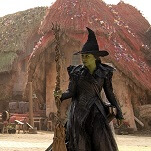Each week, Big Issues focuses on a newly released comic book of significance. This week, it’s Revenger #1. Written and illustrated by Charles Forsman (TEOTFW, Celebrated Summer), this digitally distributed issue sees the cartoonist exploring new facets of his craft as he dives into the realm of action comics. (Note: This review reveals major plot points.)
It’s a heavy week of superhero comic debuts with four new #1 issues at Marvel Comics, but the week’s most captivating new superhero series can’t be found on comic shop shelves. Charles Forsman’s Revenger stars a ruthless vigilante who travels the country fighting for the weak and exploited, and while Forsman would likely be reluctant to call her a “superhero” (he describes the series as an “action and violence comic”), Revenger wouldn’t be out of place in the grim and gritty superhero comics landscape of the late ’80s. She’s a tough-as-nails action hero but also a grieving mother with a tragic past, and those two aspects of her character spotlight different sides of Forsman as an artist.
The cartoonist behind the chilling The End Of The Fucking World (TEOTFW) and the ethereal Celebrated Summer, Forsman doesn’t create the types of stories that would ever see publication at Marvel or DC, which makes him an ideal person to tackle the superhero genre. Revenger maintains a connection to Forsman’s introspective previous works by showing how past trauma haunts the lead heroine, but it also gives him the opportunity to stage forceful fight sequences that are unlike anything he’s done before. He also considerably changes his art style for Revenger, veering away from his Charles Schulz influence to produce visuals that resemble the look of superhero comics rather than newspaper comic strips.
Forsman’s artistic shift is immediately evident from the opening sequence, which pits Revenger against three killer clowns. Forsman leaves the background completely blank for the entire scene, putting the focus on the violence as the title character eliminates each individual opponent. As she fights, Revenger narrates the horrible experience that led to her current lifestyle, adding emotional weight to the clown-beating action. The lack of a background brings a dreamlike quality to that first scene, and with no explanation regarding the reasons why Revenger is kicking clown ass, the action becomes more figurative. Is this reality? Is it a metaphor for the character’s interior conflict? Maybe it’s just an introductory fight that is supposed to look cool and doesn’t have any huge relevance to the rest of the plot. Forsman doesn’t specify, but that doesn’t diminish the scene’s impact in the slightest.
The clown brawl is an intriguing start to the story, juxtaposing gloomy narration with a fight that doesn’t take itself too seriously, and while the heroine doesn’t have much of a sense of humor, Forsman does. He understands the value of incorporating comedy into a script to diffuse tension and create a point of contrast for the drama, and with a story that goes to some very dark places, moments of lightness are invaluable in Revenger #1. When the heroine charges into the Neptune Hotel to find out what happened to a young girl that was taken from her home, the concierge asks how he can help her and she answers by punching him in the face and saying, “No one can help me.” It’s a great little joke that highlights the character’s broken loner persona, and is especially effective because Forsman firmly establishes Revenger’s emotional pain earlier in the story.
After that opening fight, the pace slows down to show Revenger in her downtime as she takes on the case of the aforementioned missing girl, and the quiet, melancholy atmosphere of the issue’s middle section is what really differentiates this book from most other action comics. After listening to a phone message detailing her new mission, Revenger sits in her car and takes the pills she needs to cope with the murder of her young son, and Forsman compacts all the character’s grief in one evocative splash page showing past events reflected in shards of cold blue glass layered on top of a close-up of the woman’s eye.
Unlike Forsman’s previous works, Revenger is in full color, and that added visual element intensifies the individual beats of the script. In the flashback splash page, the blue shards of glass pop against the brown background, and the bright red of the blood in those memories is accentuated by the cool blue that surrounds it. Those shades of blue and red also make for a smooth transition into the next page, which sees Revenger entering the city of Neptune with another splash. The desert vista has an optimistic blue sky across the top, but lying in the sand across the bottom of the page is a dead dog with a stream of red blood pouring from its head, a foreboding omen for what lies ahead.
The coloring plays an integral role in the storytelling, particularly when Revenger closes in on the missing girl. The page featuring the issue’s standout action moment begins with bold yellow and red to amplify each hit in the fight, then shifts to a sickly green when the character discovers the depraved acts taking place in the hotel. Forsman’s palette is limited, but he doesn’t need a huge array of colors when his application of a single shade is so specific and expressive.
That standout action moment is where Forsman plays around with layout to do something different with regards to how the characters interact with the panels. It begins with Revenger kicking through a door functioning as a makeshift border within a larger panel, and ends with the heroine using a small panel’s border as a hard surface to bang her opponent’s head against. Forsman isn’t the first artist to take advantage of the comic form in this way, but using this inventive approach in the very first issue suggests that this series will be a place where the cartoonist can experiment with action storytelling.
At the moment, Revenger #1 is only available as a digital comic, self-published through Forsman’s Oily Comics and for sale through Gumroad. A print edition is planned for next month, but in the meanwhile, readers can check out this first issue at an exceptional price: $2 for a digital copy, $3 for a print copy (plus digital version), and $18 for a bundle that includes the digital comic, the printed product, and an original postcard drawing from Forsman. These are all minimum amounts, and if readers want to make Forsman’s life a little easier, they are free to pay more.
It’s great to see more creators embracing the opportunities of digital distribution to build an independent comics marketplace, and offering a cheaper digital version of Revenger is an easy way for Forsman to get his new series to more readers. Forsman doesn’t have to pay any printing costs for these digital copies, and he can use the $2 (or more) from each digital sale to offset the cost of the physical comics. It’s a smart business model that will hopefully be picked up by other comics professionals in the future, catering to both print and digital readers while cutting out the middle man to deliver funds directly to the creator. Hopefully it proves fruitful, because it would be a shame to see Revenger’s life cut short after such a promising start.







































